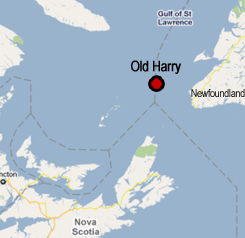The St. Lawrence Coalition issued a press release Monday denouncing numerous errors in the oil spill simulation submitted by Corridor Resources for its exploration permit in Old Harry.
Old Harry is an ecologically sensitive area of the Gulf of St. Lawrence that Corridor Resources has a permit to explore for offshore drilling. For more background, see this recent blog.
Corridor Resources was required to file an impact study with a simulation indicating what would happen were there a spill at Old Harry. The company’s simulation predicted the oil slick would evaporate in less than 24 hours and only have a dozen kilometres in diameter sphere of impact.
As described in the press release, Environment Canada experts re-evaluated the simulation and found the following errors:
– The simulation by Corridor Resources uses a mathematical model dating from the late ’70s that is completely outdated.
– Corridor Resources says that the type of oil used in their simulation evaporates within 24 hours. However, Environment Canada says that this type of oil lasts longer than 30 days.
– Corridor Resources predicted that the oil slick would not have more than 10 km in diameter and would not affect any coast. Environment Canada shows that the oil slick could travel over 100 km and reach Newfoundland and Cape Breton with a very high probability. The oil slick could even touch the coasts of Magdalen Islands.
You can compare for yourselves the Corridor Resources simulation with that of Environment Canada experts and of the David Suzuki Foundation (which found that a winter spill could impact five Atlantic provinces).
The Council of Canadians is a proud member of the Coalition which is demanding a moratorium on offshore drilling in the Gulf of St. Lawrence. We are working with the coalition on how to effectively engage in the upcoming Strategic Environmental Assessment consultations held by the Canada-Newfoundland and Labrador Offshore Petroleum Board, and beyond.




